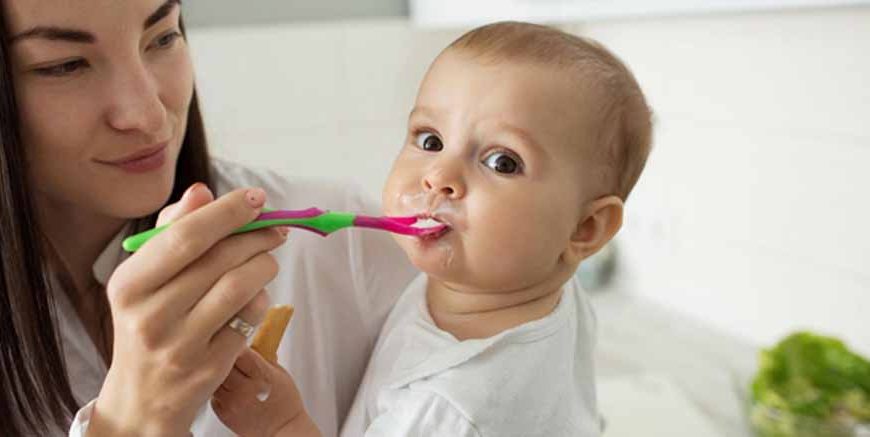‘Purees or Baby-led Weaning. Or perhaps, a combination of the two?’
The above is a dilemma that most parents of 6-month-olds find themselves facing, at a crucial moment when their baby is on the threshold of starting solid foods!
Needless to say, the two choices presented above are the ones in the limelight, when it comes to getting your babies to make that all-important transition. Now, while historically purees have been the go-to choice for all mothers, there’s no undermining the fact that of late, baby-led weaning has carved something of a name for itself.
In this article from the EuroKIds stable, you will be introduced to the baby-led weaning vs puree debate. From taking a closer look at what is baby-led weaning, to uncovering baby-led weaning pros and cons, you will find all you need to learn when it comes to making a decision whether baby-led weaning is indeed the perfect choice of ‘transition’ feeding for your little one, or not.
Ready to discover the difference between that traditional ‘spoon-feeding’ process of puree weaning, and its counterpart that is baby-led weaning? Join us, as we begin with a closer look at what is baby-led weaning!
Table of Contents
- Decoding Baby-led Weaning: A Closer Look at What is Baby-led Weaning
- Demystifying the Baby-led Weaning vs Puree Debate: Baby-led Weaning Pros and Cons
Decoding Baby-Led Weaning: A Closer Look at What is Baby-Led Weaning
You’ve undoubtedly heard of the term ‘weaning’ before, but ‘baby-led weaning?’ That seems like a far trendier name, right?
Truth be told, baby-led weaning is indeed different from its traditional ‘puree weaning’ counterpart.
- Not just Purees
- Babies are in charge
Here babies are primarily given the choice of eating ‘whole’, table foods. That means they have a wide variety of lip smacking treats to choose from!
Believe it or not, but it is the baby that actually ‘leads’ the process of feeding here. That is, they are in charge of picking up the food themselves after it has been set out in front of them. Not only that, they also decide on their own when they are ‘done’ with eating!
Note: This process of baby-led weaning is distinctly different from puree weaning, where babies are fed puree via a spoon. Also, unlike in baby-led weaning, puree weaning is ‘parent-led’, not ‘baby-led.’

Demystifying the Baby-led Weaning vs Puree Debate: Baby-led Weaning Pros and Cons
So, how does one decide whether to feed baby those purees, or instead opt in for baby-led weaning? To arrive at a conclusion, it would only be imperative to probe those Baby-led Weaning Pros and Cons!
The Pros of Baby-led Weaning vs Purees
There are plenty of reasons that baby-led weaning makes for the preferred feeding method for little babies.
- It can be less time-consuming
- Helps your little one gain some independence
- It gives them a sense of ‘control’
- Makes for the introduction of solid foods at baby’s own pace
- Helps them make sense of the world around them
Any parent will tell you, Time is a resource most precious to them!
Cool Fact: Baby-led weaning ensures that you don’t have to prepare that puree, outside of making standard meals for your family. That only means less time spent in the kitchen, and more with your baby!
What better tryst with independence, than getting to pick out foods for themselves, rather than being told what to eat?
The process of baby-led weaning ensures that your baby learns to self-regulate their hunger. What this means is, they won’t unnecessarily overeat, like they might end up doing when going for that ‘extra spoonful of puree’!
With baby-led weaning, your child will be granted the freedom to discover different foods at their own pace.
Bonus: Since they get more accustomed to solid food of all kinds, they are less likely to become picky eaters later on.
You heard that right! Babies learn through the act of ‘exploring.’ From handling the different types of food presented to them, to exploring the various shapes, sizes, textures and tastes, they get a MaterClass in learning about the world they live in!
The Cons of Baby-Led Weaning vs Purees
Nothing good in this world comes without its negatives. Presenting some of the drawbacks that might accompany the process of baby-led weaning.
- Self-feeding is not easy for all babies
- It may cause babies to ‘gag’
- It might cause an allergic reaction
Not all babies that are around 6 months of age take to the process of self-feeding easily.
Fact: This is on account of the ‘motor skills’ in these babies, being not yet as well-developed as in the case of babies who can feed on their own with ease.
While parents might believe that introducing babies to solid foods this early might cause their little ones to choke, there is not enough evidence to support this statement. However, it might just cause your baby to gag at times!
Needless to say, some of us are allergic to certain foods. This might result in your baby to develop an allergic reaction to one amongst the plethora of foods you feed them.
Tip: To help identify what foods might be triggering that allergy, you might want to introduce those solid foods to your baby, one by one.
At EuroKids we believe that there is no one method of weaning that is significantly better than the other. That being said, baby-led weaning does seem to have several significant advantages over puree weaning. Introduce your baby to solid foods when they are the right age, with either baby-led weaning, puree weaning, or perhaps a stellar combination of both!















